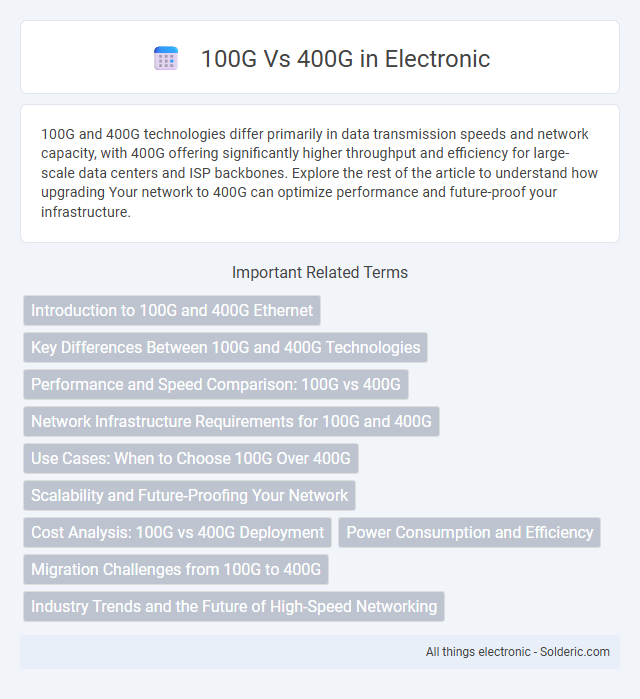100G and 400G technologies differ primarily in data transmission speeds and network capacity, with 400G offering significantly higher throughput and efficiency for large-scale data centers and ISP backbones. Explore the rest of the article to understand how upgrading Your network to 400G can optimize performance and future-proof your infrastructure.
Comparison Table
| Feature | 100G | 400G |
|---|---|---|
| Data Rate | 100 Gigabits per second | 400 Gigabits per second |
| Use Case | Data Centers, Metro Networks | High-Capacity Data Centers, Core Networks |
| Technology | Single wavelength or 4x25G channels | 4x100G channels, PAM4, or Coherent Optics |
| Cost | Lower initial investment | Higher initial investment, cost-efficient per bit |
| Power Consumption | Lower power per device | Higher power but lower per bit |
| Reach | Short to medium haul | Extended reach with advanced modulation |
| Applications | Enterprise Connectivity, Metro Ethernet | Cloud Computing, Hyperscale Networks |
Introduction to 100G and 400G Ethernet
100G Ethernet delivers high-speed data transmission at 100 gigabits per second, widely adopted for enterprise and data center networking, offering enhanced bandwidth and improved efficiency over previous standards. 400G Ethernet quadruples this capacity, targeting hyperscale data centers and cloud providers with ultra-high throughput requirements, leveraging advanced modulation and parallel optics technologies. Both standards support seamless scalability, low latency, and energy efficiency, enabling next-generation networking infrastructure to accommodate growing data traffic demands.
Key Differences Between 100G and 400G Technologies
100G and 400G technologies differ primarily in data transmission speed, with 400G providing quadruple the bandwidth of 100G, supporting higher network capacity and faster data processing. The 400G standard typically uses advanced modulation formats like PAM4 and coherent optics to achieve improved spectral efficiency and longer reach compared to 100G. Infrastructure costs and power consumption are higher for 400G, but it enables scalable solutions essential for data centers, cloud services, and 5G network expansion.
Performance and Speed Comparison: 100G vs 400G
400G technology offers quadruple the bandwidth of 100G, significantly enhancing data transfer speeds and network performance for high-capacity environments. Your network can benefit from reduced latency and increased throughput when upgrading to 400G, making it ideal for data centers and telecom infrastructures demanding rapid, large-scale data handling. While 100G remains sufficient for many applications, 400G provides future-proof scalability and efficiency critical for evolving digital workloads.
Network Infrastructure Requirements for 100G and 400G
Network infrastructure for 100G typically involves standard QSFP28 transceivers and requires fewer fibers and less complex multiplexing compared to 400G, which demands advanced CFP8 or OSFP modules and higher-density fiber arrangements. Your network must support enhanced power delivery, cooling, and signal processing capabilities to accommodate 400G's increased bandwidth and tighter optical specifications. Upgrading to 400G also requires more sophisticated switching hardware and increased capacity in data center interconnects to handle the exponential growth in data traffic effectively.
Use Cases: When to Choose 100G Over 400G
100G Ethernet is ideal for enterprise data centers and metro networks where cost efficiency and lower power consumption are crucial for moderate traffic loads. It suits applications such as server connectivity, storage area networks, and regional data aggregation that don't require the ultra-high bandwidth offered by 400G. Choosing 100G over 400G is practical for scalable growth and budget-conscious deployments without the complexity and expense of advanced 400G optics and transceivers.
Scalability and Future-Proofing Your Network
400G technology offers significantly enhanced scalability compared to 100G, supporting higher bandwidth demands and more efficient data center operations. Its advanced modulation techniques and increased wavelength capacity enable seamless network expansion and accommodate future traffic growth without frequent infrastructure overhauls. Investing in 400G ensures future-proofing by providing the flexibility and performance required for emerging applications like AI, IoT, and 5G networks.
Cost Analysis: 100G vs 400G Deployment
400G deployment offers a lower cost per gigabit compared to 100G, driven by increased bandwidth efficiency and reduced optical transceiver expenses. While initial capital expenditures (CapEx) for 400G infrastructure can be higher, operational expenditures (OpEx) benefit from simplified network architecture and lower power consumption. Network operators realize improved total cost of ownership (TCO) by leveraging 400G technology in high-density data center and carrier environments.
Power Consumption and Efficiency
400G technology offers significantly improved power efficiency compared to 100G, delivering up to four times the data throughput with less than four times the power consumption. Advances in modulation formats and integrated photonics have reduced the energy-per-bit metric, making 400G more suitable for large-scale data centers and high-performance computing environments. As a result, 400G enables higher bandwidth density while lowering operational costs and carbon footprint.
Migration Challenges from 100G to 400G
Migration from 100G to 400G involves significant challenges including the need for upgraded infrastructure, such as enhanced fiber optics and higher-capacity switches to support increased bandwidth and reduce latency. Network operators face complexities in managing power consumption and thermal dissipation due to the denser, more power-intensive 400G modules. Interoperability with existing 100G equipment and ensuring backward compatibility further complicate seamless network transition and operational continuity.
Industry Trends and the Future of High-Speed Networking
400G Ethernet is rapidly becoming the industry standard for high-speed networking, driven by exponential data growth and the demands of cloud computing, AI, and 5G technologies. Data centers and service providers are investing heavily in 400G infrastructure to achieve higher bandwidth, improved energy efficiency, and reduced latency compared to 100G solutions. The future trajectory points towards scalable, cost-effective 400G deployments enabling seamless multi-terabit networks that support evolving digital ecosystems.
100G vs 400G Infographic

 solderic.com
solderic.com